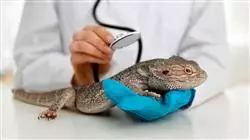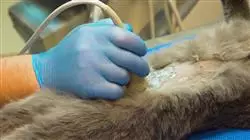University certificate
The world's largest faculty of veterinary medicine”
Introduction to the Program
This specialization offers the bases and tools for you to become an expert in veterinary ultrasound taught by recognized professionals with extensive experience in the field”

Ultrasound in Feline Patients and Exotic Animals has become a basic diagnostic imaging procedure nowadays and is increasingly performed and required in daily clinical practice. It provides us with very relevant and sometimes conclusive information to reach a diagnosis in our patients.
This training will deepen your knowledge not only in the technical differences and how to apply them to obtain an excellent examination, but will also address the main pathologies that we can diagnose with the use of ultrasound in the chest, abdomen and cervical region. It will also cover the ultrasound and differential signs of these pathologies and other techniques that can be used to reach the definitive diagnosis.
However, ultrasound is not a commonly-used diagnostic tool in exotic animal clinics. The large number of species included in this field, the anatomical differences and the different methods of restraint mean that the clinician is not confident in the use of this imaging technique.
Technological advances and the development of new equipment with higher resolution have allowed the progression of ultrasound in these varied species, making it an essential diagnostic test.
Given the online format of this program, you will develop confidence, assurance and greater knowledge of pathologies and differential diagnoses when it comes to providing relevant and necessary information in daily ultrasound practice.
As it is an online program, the student is not conditioned by fixed schedules, nor do they need to move to physically move to another location. All of the content can be accessed at any time of the day, so you can balance your working or personal life with your academic life.
As the course is online, you will be able to train wherever and whenever you want, balancing your personal and professional life”
This Postgraduate diploma in Ultrasound in Feline Patients and Exotic Animals offers you the advantages of a high-level scientific, teaching, and technological course. These are some of its most notable features:
- Latest technology in online teaching software
- Highly visual teaching system, supported by graphic and schematic contents that are easy to assimilate and understand
- Practical cases presented by practising experts
- State-of-the-art interactive video systems
- Teaching supported by telepractice
- Continuous updating and recycling systems
- Self-regulating learning: full compatibility with other occupations
- Practical exercises for self-evaluation and learning verification
- Support groups and educational synergies: questions to the expert, debate and knowledge forums
- Communication with the teacher and individual reflection work
- Content that is accessible from any fixed or portable device with an Internet connection
- Supplementary documentation databases are permanently available, even after the course
Achieve comprehensive and relevant training in Ultrasound in Feline Patients and Exotic Animals with this highly effective Postgraduate diploma and open new pathways for your professional progress"
Our teaching staff is made up of professionals from different fields related to this specialty. In this way, we ensure that we provide you with the training update we are aiming for. A multidisciplinary team of professionals trained and experienced in different environments, who will cover the theoretical knowledge in an efficient way, but, above all, will put the practical knowledge derived from their own experience at the service of the course: one of the differential qualities of this course.
This mastery of the subject is complemented by the effectiveness of the methodological design of this Postgraduate diploma in Ultrasound in Feline Patients and Exotic Animals . Developed by a multidisciplinary team of e-learning experts, it integrates the latest advances in educational technology. In this way, you will be able to study with a range of easy-to-use and versatile multimedia tools that will give you the necessary skills you need for your specialization.
The design of this program is based on Problem-Based Learning: an approach that conceives learning as a highly practical process. To achieve this remotely, we will use telepractice: with the help of an innovative interactive video system, and learning from an expert, you will be able to acquire the knowledge as if you were actually dealing with the scenario you are learning about. A concept that will allow you to integrate and fix learning in a more realistic and permanent way.
Learn from real cases with this highly effective educational Postgraduate diploma and open up new paths to your professional progress"

Immerse yourself in this training of the highest educational quality, which will allow you to face future challenges that may arise during daily practice in Ultrasound in Feline Patients and Exotic Animals "
Why study at TECH?
TECH is the world’s largest online university. With an impressive catalog of more than 14,000 university programs available in 11 languages, it is positioned as a leader in employability, with a 99% job placement rate. In addition, it relies on an enormous faculty of more than 6,000 professors of the highest international renown.

Study at the world's largest online university and guarantee your professional success. The future starts at TECH”
The world’s best online university according to FORBES
The prestigious Forbes magazine, specialized in business and finance, has highlighted TECH as “the world's best online university” This is what they have recently stated in an article in their digital edition in which they echo the success story of this institution, “thanks to the academic offer it provides, the selection of its teaching staff, and an innovative learning method aimed at educating the professionals of the future”
A revolutionary study method, a cutting-edge faculty and a practical focus: the key to TECH's success.
The most complete study plans on the university scene
TECH offers the most complete study plans on the university scene, with syllabuses that cover fundamental concepts and, at the same time, the main scientific advances in their specific scientific areas. In addition, these programs are continuously being updated to guarantee students the academic vanguard and the most in-demand professional skills. In this way, the university's qualifications provide its graduates with a significant advantage to propel their careers to success.
TECH offers the most comprehensive and intensive study plans on the current university scene.
A world-class teaching staff
TECH's teaching staff is made up of more than 6,000 professors with the highest international recognition. Professors, researchers and top executives of multinational companies, including Isaiah Covington, performance coach of the Boston Celtics; Magda Romanska, principal investigator at Harvard MetaLAB; Ignacio Wistumba, chairman of the department of translational molecular pathology at MD Anderson Cancer Center; and D.W. Pine, creative director of TIME magazine, among others.
Internationally renowned experts, specialized in different branches of Health, Technology, Communication and Business, form part of the TECH faculty.
A unique learning method
TECH is the first university to use Relearning in all its programs. It is the best online learning methodology, accredited with international teaching quality certifications, provided by prestigious educational agencies. In addition, this disruptive educational model is complemented with the “Case Method”, thereby setting up a unique online teaching strategy. Innovative teaching resources are also implemented, including detailed videos, infographics and interactive summaries.
TECH combines Relearning and the Case Method in all its university programs to guarantee excellent theoretical and practical learning, studying whenever and wherever you want.
The world's largest online university
TECH is the world’s largest online university. We are the largest educational institution, with the best and widest online educational catalog, one hundred percent online and covering the vast majority of areas of knowledge. We offer a large selection of our own degrees and accredited online undergraduate and postgraduate degrees. In total, more than 14,000 university degrees, in eleven different languages, make us the largest educational largest in the world.
TECH has the world's most extensive catalog of academic and official programs, available in more than 11 languages.
Google Premier Partner
The American technology giant has awarded TECH the Google Google Premier Partner badge. This award, which is only available to 3% of the world's companies, highlights the efficient, flexible and tailored experience that this university provides to students. The recognition as a Google Premier Partner not only accredits the maximum rigor, performance and investment in TECH's digital infrastructures, but also places this university as one of the world's leading technology companies.
Google has positioned TECH in the top 3% of the world's most important technology companies by awarding it its Google Premier Partner badge.
The official online university of the NBA
TECH is the official online university of the NBA. Thanks to our agreement with the biggest league in basketball, we offer our students exclusive university programs, as well as a wide variety of educational resources focused on the business of the league and other areas of the sports industry. Each program is made up of a uniquely designed syllabus and features exceptional guest hosts: professionals with a distinguished sports background who will offer their expertise on the most relevant topics.
TECH has been selected by the NBA, the world's top basketball league, as its official online university.
The top-rated university by its students
Students have positioned TECH as the world's top-rated university on the main review websites, with a highest rating of 4.9 out of 5, obtained from more than 1,000 reviews. These results consolidate TECH as the benchmark university institution at an international level, reflecting the excellence and positive impact of its educational model.” reflecting the excellence and positive impact of its educational model.”
TECH is the world’s top-rated university by its students.
Leaders in employability
TECH has managed to become the leading university in employability. 99% of its students obtain jobs in the academic field they have studied, within one year of completing any of the university's programs. A similar number achieve immediate career enhancement. All this thanks to a study methodology that bases its effectiveness on the acquisition of practical skills, which are absolutely necessary for professional development.
99% of TECH graduates find a job within a year of completing their studies.
Postgraduate Diploma in Ultrasound in Feline and Exotic Animal Patients.
Ultrasonography is a diagnostic imaging technique that uses high-frequency sound waves to produce real-time images of internal organs and tissues in the body of animals. To perform an ultrasound on a feline or exotic animal patient, the veterinarian will first apply a conductive gel to the area of the body to be examined, and then use an ultrasound transducer to produce real-time images of the body's internal organs and tissues. The echo-generated image on the screen will allow images of the internal organs, soft tissues, cardiovascular system and musculoskeletal system to be viewed.
Ultrasound is a painless technique and is usually performed without sedation of the patient. The animal does not need any special preparation prior to the ultrasound, although in some cases, the animal may need to be fasted to obtain images of the stomach and intestine. Ultrasonography is an important tool for the diagnosis and monitoring of a wide variety of medical conditions in animals, such as liver disease, kidney disease, diseases of the gastrointestinal tract, diseases of the cardiovascular system, and musculoskeletal diseases.
Sonography is a commonly used diagnostic imaging technique in feline and other exotic animal patients. It is a non-invasive, painless technique that can help the veterinarian diagnose various health problems in the animal. If your pet needs an ultrasound, a trained and experienced veterinarian can guide you through the procedure and provide you with all the necessary information.
TECH the world's largest digital university has an academic program designed to provide students with the skills and knowledge necessary to perform ultrasounds on cats and exotic animals, and to interpret the images accurately. Students will also learn how to apply ultrasound in the diagnosis and treatment of various diseases and how to use this technique to improve veterinary practice.







